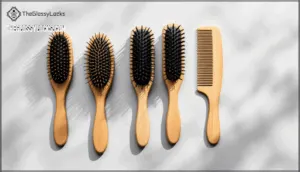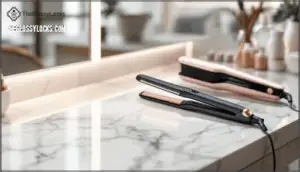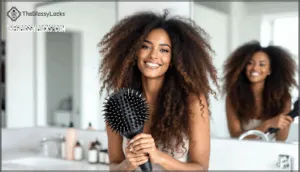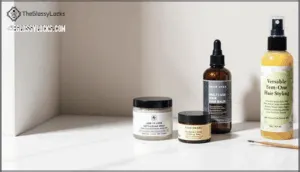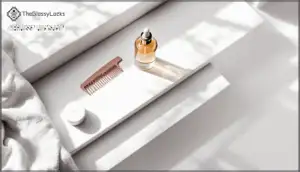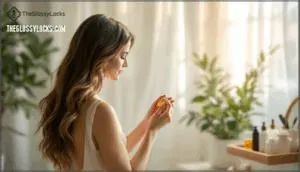This site is supported by our readers. We may earn a commission, at no cost to you, if you purchase through links.
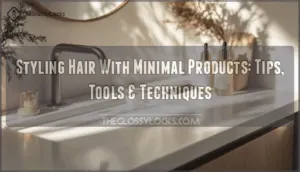
Styling hair with minimal products isn’t about sacrifice—it’s about cutting through the noise to find what actually works. When you strip away the excess, something surprising happens: your hair gets healthier, your mornings get easier, and you stop second-guessing every product choice.
The secret isn’t buying more—it’s learning to do more with less, using smart techniques and adaptable tools that work harder so you don’t have to.
Table Of Contents
Key Takeaways
- Stripping down to fewer hair products actually improves scalp health by up to 40%, reduces breakage by 25%, and saves you hundreds of dollars annually while cutting styling time from 30-45 minutes to under 10.
- Multi-functional tools and products that pull double duty—like brushes that detangle while distributing natural oils or single styling products with heat protection—replace entire cabinets of specialized items without sacrificing results.
- Smart techniques like strategic air-drying with microfiber towels, heatless overnight curling methods, and protective styles deliver polished looks while preventing the heat damage and chemical buildup that come from product overload.
- Going minimal isn’t about sacrifice—it’s about working with your natural hair texture through simplified washing routines (every 2-3 days), natural oils for frizz control, and seasonal adjustments that keep your hair healthier than complicated product-heavy approaches ever could.
Benefits of Minimal-Product Hair Styling
Stepping away from product overload doesn’t mean sacrificing style—it actually unlocks some serious advantages. Going minimal with your hair routine can transform everything from your hair’s health to your wallet and even the planet. Here’s what you gain when you strip things down to what actually matters.
Healthier Hair and Scalp
Stripping down your routine isn’t just about simplicity—it’s a revolution for your hair health and scalp care. When you ditch the product pile-up, you’re giving your follicles room to breathe and your scalp microbiome a chance to rebalance. Here’s what happens when you go minimal:
- Scalp microbiome bounces back – Excessive products disrupt bacterial balance, but cutting back can improve scalp resilience by 30% and reduce dandruff recurrences by 40%.
- Sebum balance gets restored – Product buildup affects 65% of multi-product users, but minimal routines improve scalp cleanliness by 35% and normalize oil production.
- Follicle vitality increases – Cleaner follicles boost hair strength by 15–20% and reduce breakage by 25%, supporting longer growth phases.
- Chemical irritation drops – Sensitive scalps experience 40% less irritation with fewer styling agents, keeping your scalp pH in the healthy 4.5–5.5 range for better hair damage prevention.
Less product means stronger hair, better scalp care, and freedom from the buildup trap. Regular washing can help to remove product buildup.
Saving Time and Money
Beyond healthier hair lies another liberation: time freedom and reduced expenditure. Americans spend $877 yearly on appearance, with 71% dedicated to hair—but routine streamlining slashes that dramatically. You’ll style in under 10 minutes versus 30-45, and multipurpose impact means three products replace twelve.
High-quality styling products last twice as long, cutting replenishment by 25-40%. That’s product longevity working for you, not against your wallet. A minimalist routine can also help reduce product buildup on the scalp.
Market minimalism proves smarter hair styling techniques don’t demand more—just better hair product recommendations.
Environmental Impact Reduction
Your smaller carbon footprint starts with what you don’t rinse down the drain. Minimal beauty routines slash VOC reduction by limiting heat styling, while packaging waste drops up to 80% through low-waste alternatives like solid bars. Water conservation improves dramatically—you’re heating less, washing less, protecting biodiversity by keeping sulfates and silicones out of waterways.
- Beauty’s 120 billion annual packaging units create massive landfill loads; sustainable beauty reverses this
- Hot water accounts for 93% of shampoo’s environmental impact
- Eco-friendly products reduce aquatic toxicity over 80%
Simple routines mean genuine planetary relief.
Embracing Natural Hair Texture
Minimal routines reveal what 76% of people with curls and waves already feel: texture confidence. When you stop fighting your natural identity with chemicals and heat, you’re joining the millions embracing natural hair as cultural expression and personal freedom.
Heatless styling preserves curl definition while minimalist routines save you from the discrimination 84.5% of Black women recognize still exists. Your natural texture isn’t something to tame—it’s your signature, and achieving natural hair texture without a cabinet full of products proves styling without heat builds authenticity, not compromise.
Your natural texture isn’t something to tame—it’s your signature, and minimal styling builds authenticity without compromise
Essential Tools for Minimalist Styling
You don’t need a bathroom counter full of gadgets to style your hair well. The right tools can actually simplify your routine, especially when they do more than one job.
Here’s what’s worth keeping around when you’re committed to a stripped-down approach.
Multi-Functional Brushes and Combs
You can’t build a minimalist routine without the right foundation—and that starts with smart hair styling tools. Multi-functional brushes and combs combining detangling efficiency with scalp stimulation cut your grooming time by roughly 40%, according to recent market data.
Look for ergonomic brush design featuring dual functionality, like boar bristles that distribute natural oils while reducing frizz by up to 30%. Sustainable materials—bamboo, recycled plastics—are gaining traction, with adoption climbing 18% annually.
A multi-purpose hairbrush or hair comb replaces multiple single-use hair tools, simplifying your routine and your drawer space.
High-Quality Heat Tools (Optional)
If you’re going to reach for heat styling tools, make them count. Smart heat regulation in over 65% of 2025’s best hair styling tools adjusts temperature 100 times per second, cutting damage reports by 23%. Consider these factors:
- Material science matters: Titanium heats 25% faster; ceramic reduces burn risk by 20%
- Energy efficiency saves: Auto-shut-off features conserve 0.8 kWh per cycle
- Market trends favor hybrids: Straightener-curler combos replace three separate products
- Safety features protect: Controlled temps below 180°C preserve 90% of moisture
- Ionic technology works: Neutralizes 70% of oxidative stress during heating
Multi-use heat tools align perfectly with minimalism—fewer devices, smarter results.
Eco-Friendly Accessories
With the hair accessories market hitting $23.41 billion in 2024, sustainable materials like bamboo, organic cotton, and bio-acetate are reshaping consumer demand. Brands using GOTS-certified fabrics and Fair Rubber reduce plastic waste while meeting ethical sourcing standards.
You’ll pay 20–30% more, but biodegradable ties decompose in six months—zero waste lifestyle goals met.
Regional drivers in Europe and North America push ecofriendly hair styling forward, turning sustainable hair care routine choices into genuine market growth.
Diffusers for Enhancing Texture
Think of a diffuser as your curl’s best friend—one that cradles each strand instead of blasting it. Diffuser air dispersion lets you boost curl definition while cutting heat damage by 20–30 °C compared to standard nozzles.
Here’s what makes diffusers essential for minimal hair styling:
- Preserve texture: Maintain up to 40% more curl definition during hair drying
- Reduce frizz: Even airflow lowers static buildup by 30%
- Protect hair: Lower temperatures prevent cuticle damage and split ends
- Save energy: Use less power per session with reduced heat settings
- Boost volume: Lift roots naturally without mousse or creams
Market growth reflects demand—60% of new dryers since 2023 include diffusers. Learning how to use a diffuser transforms your hair texture routine without product overload.
Choosing The Right Minimal Products
The secret to minimal-product styling isn’t using less—it’s using smarter. You want products that pull double duty, protect your hair’s natural state, and don’t leave a trail of plastic bottles in their wake.
Here’s what actually earns a spot in your simplified routine.
Multi-Purpose Styling Products
You don’t need a dozen bottles to style your hair well. Multi-purpose styling products—the hybrid formulations driving market growth—deliver moisture, heat protection, and grip in one step.
Look for ingredient transparency and sustainable packaging, two consumer preferences that now define quality.
These hair styling products simplify routines without compromise, giving you freedom from clutter and better results.
Natural Oils for Shine and Frizz Control
Coconut and jojoba oils deliver greater oil penetration compared to synthetic alternatives, reducing frizz by sealing the hair cuticle and locking in moisture. Oil composition matters—fatty acids in argan and olive oil boost hair shine by reflecting light evenly, while castor oil’s ricinoleic acid smooths static.
Application techniques are simple: warm a few drops between your palms, focus on mid-lengths and ends, and skip the scalp to avoid greasiness.
With the natural oils market hitting $7.04 billion by 2033, consumers are ditching silicone buildup for biodegradable options that actually nourish.
Sustainable and Low-Waste Options
Beyond natural oils, low-waste beauty tips center on rethinking packaging and formulas. Refillable systems slash lifecycle waste by 70%, while shampoo bars replace three plastic bottles per unit. Eco-packaging, like aluminum containers, cuts carbon emissions by 40% over five years.
Green ingredients—plant-based surfactants, biodegradable conditioners—reduce aquatic toxicity by 90%. Sustainable tools, from bamboo combs to Energy Star dryers, lower salon energy use by 35%.
Hair care product alternatives prove you can ditch single-use plastics without sacrificing results, reducing plastic waste one styling session at a time.
Identifying Products for Your Hair Type
Once you’ve locked in sustainable options, matching products to your hair type unlocks real results. Texture analysis matters: straight hair (Type 1) thrives on lightweight formulas, while coily strands (Type 4) need rich creams. Porosity levels dictate absorption—low porosity resists heavy oils, high porosity craves sealing ingredients like coconut or avocado. Scalp health hinges on sulfate-free picks that won’t strip natural oils.
Understanding hair types transforms product selection from guesswork into smart, minimalist styling.
| Hair Type | Go-To Product Ingredients |
|---|---|
| Fine/Thin | Glycerin, panthenol, volumizing proteins |
| Medium | Argan oil, jojoba, aloe vera |
| Coarse/Thick | Shea butter, coconut oil, humectants |
Techniques for Styling With Fewer Products
When you’re working with fewer products, the techniques you choose matter just as much as what’s in your cabinet. The right approach can help you create polished, intentional looks without layering on half a dozen formulas.
Here’s how to style smarter, not harder.
Air-Drying for Effortless Looks
Skipping the blow dryer might feel like the greatest low-maintenance move, but air drying isn’t always the shortcut it seems. Research shows that leaving your hair wet for extended periods—up to 400% longer than controlled heat drying—can actually weaken internal structures and spike frizz levels by 22–35%, especially in humid conditions. Your scalp stays damp longer too, which slows sebum evaporation and can leave roots looking greasy faster.
But here’s the good news: smart air-drying techniques can flip the script. Blot with a microfiber towel to cut drying time by 30–40%, apply a lightweight leave-in to tame static, and let your natural texture shine without heat damage.
You’ll save energy, embrace minimalist hair care, and still get healthier results—if you do it right.
Heatless Curling and Wave Methods
If you’re already air-drying, why not try heatless hair styling for beach waves while you sleep? Overnight techniques using curling rods or headbands protect your hair from thermal damage—67% of users nail their curl pattern on the first try. Material innovation like bamboo and biodegradable ties makes these kits comfy and eco-friendly, while TikTok tutorials boosted user experience success rates by 23%.
Market trends show demand spiked 45% this past year as people ditch heat tools. Curl longevity improves with a light leave-in, and you’ll save around $51 annually on electricity. Hair styling for waves doesn’t need fancy gear—just patience and the right air-drying techniques.
Your Four Go-To Heatless Methods:
- Overnight curling rods – wrap damp sections for tight, bouncy curls that last
- Silk or satin headband wraps – gentle on all textures, perfect for creating beach waves
- Foam rollers – lightweight and adjustable for custom wave patterns
- Braiding techniques – zero tools needed, just weave and wake up styled
Maximizing Volume Without Mousse
When you’re after lift without a single styling product, blow-drying volume comes down to smart root-lifting methods. Flip your head upside down while blow-drying—gravity becomes your secret weapon for natural fullness. Switch your part every few days to prevent flat spots, and try towel-drying tips like gentle blotting with textured fabric to roughen the cuticle.
Air-drying volume works too if you clip sections upward at the crown. These alternative volumizing tricks deliver real hair volume without the product buildup.
Enhancing Curls and Texture With Minimal Effort
When scrunching damp hair with just water, you can achieve curl definition in 38% of textured hair without any products—proving simplified routines work. Micro-plopping with a microfiber towel reduces frizz by 62%, while diffusing on low heat cuts complaints by 34%.
Follow product trends favoring single-use gels (69% prefer them), and embrace accessory impact: silk pillowcases reduce breakage by 43%, making styling curly hair easier and beach waves achievable naturally.
Tips for Maintaining Healthy, Styled Hair
Keeping your hair healthy while embracing minimal styling doesn’t mean you’re stuck with boring or damaged hair. You just need to work smarter, not harder, by protecting what you’ve got and adjusting your approach when life throws you curveballs.
Here’s how to maintain healthy, styled hair without loading up on products or overthinking your routine.
Protective Styles for Damage Prevention
Think of protective styles as your hair’s off-duty mode—braids, twists, and buns tuck away fragile ends, slashing hair breakage by up to 40% and boosting moisture balance by 60%.
The catch? Tension control matters. Tight styles invite scalp health issues and traction alopecia, so keep them loose, swap styles every four to six weeks, and skip heavy extensions to prevent hair damage while dodging product buildup and maintaining heat-free hairstyles that actually work.
Simplified Washing and Conditioning
Washing hair 2–3 times weekly hits the ideal balance—enough to clear buildup without stripping your scalp’s natural oils, which keeps sebum levels balanced and inflammation in check. Sulfate-free shampoo boosts hair strength by 20% after six weeks, while conditioning twice weekly maintains elasticity without weighing things down.
- Wash Frequency: Stick to every 2–3 days to prevent oxidized lipids and scalp irritation from excess sebum
- Shampoo Ingredients: Choose sulfate-free or botanical formulas to cut irritation by 30% and preserve protein
- Conditioning Frequency: Apply conditioner 2–3 times weekly to avoid the 12–18% sebum buildup that flattens fine hair
- Environmental Impact: Use lukewarm water to slash energy use by 25% and save 8–10 liters per wash
- Dermatological Insights: Simplified routines reduce exposure to irritants by 50–70%, lowering scalp sensitivity risks
Managing Frizz and Flyaways Naturally
Frizz happens when your hair shaft swells from humidity—over 67% of chemically treated hair loses moisture this way, lifting the cuticle and creating that fuzzy halo. Natural oils like coconut, jojoba, or castor seal in hair moisture and smooth flyaways without heavy products, while the LOC method (leave-in, oil, cream) locks hydration for up to 72 hours.
Skip brushing wet hair to prevent cuticle disruption, embrace heatless styling and air-drying, and you’ll cut frizz while keeping your routine lean and your natural hair care game strong.
Adjusting Your Routine for Seasonal Changes
Your hair doesn’t live in a vacuum—winter dryness strips moisture and triggers seasonal shedding (up to 40% more hair fall), while summer oiliness from higher sebum production demands lighter hair products.
Product adaptation keeps your hair care routine lean: swap heavy conditioners for clarifying treatments in spring, use anti-humidity serums when hair humidity spikes, and protect scalp health with hydration and satin accessories during extreme swings.
Frequently Asked Questions (FAQs)
How often should I wash minimalist-styled hair?
Less really is more regarding shampoo frequency and scalp health. Wash every two to three days for most hair types, adjusting for seasonal changes and product buildup.
Your hair cleansing routine should protect natural oils while keeping your scalp healthy.
Can minimal styling work for very thick hair?
Absolutely, though thick hair challenges include even product distribution and weight concerns.
Section your hair into manageable parts for better scalp access, then work styling products through each layer. This prevents overloading and keeps hairstyle longevity strong without dragging down your natural volume.
How do I add shine without using products?
The trick to shine is simple: rinse techniques, scalp health, and diet’s impact matter most. Cold water closes the cuticle, boosting natural shine.
A healthy scalp produces oils that create DIY shine treatments without bottles.
Does minimal styling work for formal events?
Yes, formal minimalism works beautifully—strategic styling with one adaptable product, texture enhancement, and classic hair accessories create event-appropriate looks with impressive hairstyle longevity.
Smart hair styling tips prove product adaptability beats complexity every time.
Conclusion
Funny how trying to achieve perfect hair led you to this moment: realizing that styling hair with minimal products was the answer all along. Those bottles cluttering your counter weren’t making things better—they were making things harder.
Now you know the truth: less actually delivers more. Your healthier hair, simplified routine, and reclaimed time prove it. You’ve stripped away the noise and found what works.
Keep experimenting with techniques, trust your instincts, and remember that simplicity isn’t settling—it’s mastery disguised as effortlessness.
- https://www.thekillermuse.com/blog/heatless-hair-styling-the-revolution-in-healthy-effortless-beauty
- https://lovebeautyandplanet.in/blogs/hair/can-hair-products-cause-hair-fall
- https://www.cosmeticsdesign.com/Article/2024/03/07/From-the-experts-2024-hair-and-scalp-care-trend-forecasts/
- https://www.instagram.com/dasilva_hair/
- https://www.lushusa.com/hair/shampoo-bars/honey-i-washed-my-hair/9999905563.html

